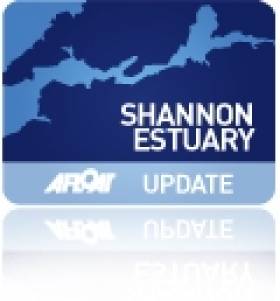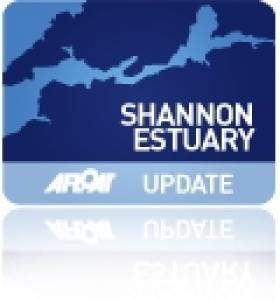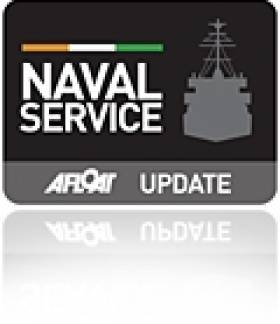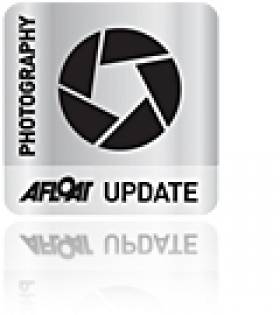Displaying items by tag: Shannon Estuary
Foynes Prepares to Stage Mermaid Week
Foynes Yacht Club on the Shannon Estuary is hosting the National Mermaid Championships, which will commence on Saturday, July 31, and which will be taking place for a full week at Cooleen Point.
Quite an amount of preparation and organisation is taking place to ensure that it will be one of the most successful championships to date.
Entries are expected to exceed 40 boats that will compete in the championship's. These boats are a classic 1932 design from all corners of Ireland, which will be racing daily for seven days on the majestic Shannon Estuary waters to the picturesque and historic port village of Foynes.
The competition brings with it a festival atmosphere, as over 150 sailors with their families and friends settle in for a week packed, competitive and social activities by day and night.
An action-packed programme of events will take place during the championships 'off the water', and this will commence on Saturday, July 31 with Karaoke; on Sunday, August 1 music will be provided by 'Motive'.
On Monday, August 2 a 'Family Fun Day' in Cooleen Point will take place, and this will feature a fundraising family fun, and games in aid of the Royal National Lifeboat Institution.
Besides such activities as a Bouncy Castle, Bar-B-Que, Karaoke and many more events, and the first ever sponsored Mud Splat Obstacle Course race, which will make very entertaining viewing.
And an added spectacle on Monday an air display from the Coastguard Helicopter based in Shannon, Co. Clare will take place.
A quiz night will take place on Tuesday, August 3, and on Wednesday, August 4, a Traditional music session will take place; on Thursday, August 5 a Comedy night is organised.
The Royal National Lifeboat Institution has saved more than 139,000 lives since its foundation in 1824. Through the years, there have been countless stories of courage against a background of technological developments and social change.
The charity was founded as the national institution for the preservation of life from shipwreck after an appeal was made by Sir William Hillary. Hillary lived in Douglas on the Isle of Man, and had witnessed the wrecking of dozens of ships from his home.
The name was changed to the Royal National Lifeboat Institution in 1854, and cork lifejackets were first issued to crew members in the same year.
In 1891, the first RNLI street collection was held in Manchester, and the 20th century saw the RNLI continue to save lives through two world wars.
The lifeboats moved from sail and oar power to petrol and diesel, and the first women joined their crews.
Recent years have seen major develpments with the introduction of RNLI lifeguards in 2001, and the first lifeboat station on an inland water in the same year.
There are 43 RNLI lifeboat stations in Ireland, where the nearest to Foynes is in Kilrush. The money raised from Mermaid week for the RNLI will be put to good use by RNLI personnel, where it will fund new equipment including lifeboats, seafaring wear, lifejackets and much more.
Foynes Yacht Club, Commodore Tom Murray is making a special appeal to all Mermaid sailors, club members and friends to come to the club and support this very worthy cause. 'The RNLI relies on the support of all the sailing and yacht clubs in the country for donations to keep this very important sea rescue operation running', he said.
Crew and assistance for crash boats will be wanted for the championships, so any member, who is interested in sailing or would like to help in the running of the championships are asked to please contact Commodore Tom Murray on 087 2563515; Mermaid Class Captain, Conor Roche on 086 8030343 or Cruiser Class Captain, Alan McEneff on 086 2568280 immediately.
The club website is www.foynesyachtclub.com
The West of Ireland Offshore Racing Association (WIORA), 'West Coast Championships' concluded at the weekend, which was hosted by the Royal Western Yacht Club based in Kilrush Co. Clare.
Strong winds prevailed thought the event and unfortunately no sailing took place on Friday due to the extreme wind conditions, but international race officer Alan Crosbie and his team did an excellent job in getting six races completed for each of the four classes; On the last day, race management was conducted from the Navel Ship the LE Aoife making a visit to Kilrush and adding greatly to the spectacle afloat. Photos on the gallery here.
Numbers may have be back on previous years but what was lacking in numbers was made up for by the standard and competiveness of the racing in each of the classes, so much so that in Class 2 it went to the wire on the final race of the final day to decide the overall placing in the Class with the order they finished in deciding the order of the class overall's.
In these economic times without the huge support of partners, events like this Regional Event could not be staged and with alot of help from Kilrush Credit Union / Kilrush Creek Marina / Shannon Development / Dubarry Ireland / Kilrush Chamber of Commerce / ropelocker.ie / fotosail.com / afloat.ie and the many local business made sure this was a very successful event.
In IRC Class 1, Glen Cahill's J109 Joie de Vie from Galway Bay Sailing Club took the overall slot with Rob Allen's Corby 36 Mustang Sally from the host club finishing in second and Martin Breen's Harley 33 That's Life also from Galway Bay Sailing Club finishing a close third overall. In Echo Class 1, Rob Allen's Mustang Sally took the overall laurels with Team Foynes X332 from Foynes Yacht Club finishing second on equal points with Glen Cahill's J109 who finished third only been separated by count back on points.
In IRC Class 2, only three points separated the top three boats with Ray McGibney's Dehler 34 DISARAY sailing under the burgee of Foynes Yacht Club taking the final race and the overall in the class with Brian Rafferty's Corby 26 2602 from Sligo Yacht Club finishing only one and half points adrift securing second and Finbarr O Connell's Sigma 33 from Tralee Bay Sailing Club finishing a very close third. In Echo Class 2 it was even closer on points with only .75 of a point separating the top three with Liam Lynch's Sigma 33 from Tralee Bay Sailing Club taking the overall with Brian Rafferty's 2062 finishing second and Finbarr O Connells Treyona finishing third overall.
In IRC Class 3, Martin McNamara & Thomas Whelan's Chartered J24 Jaws/Chaos from the host club with four wins took the top slot with John Paul Buckley & Donal McCormack's Golden Shamrock Battle from Foynes Yacht Club finishing second and Gary Fort's chartered J24 Jaguar from Tralee Bay Sailing Club taking third overall. In Echo Class Three John Paul Buckley & Donal McCormack's Battle taking first with Gary Fort's Jaguar taking second and fellow club mate from Tralee Bay Sailing Club Mark Prendiville HB31 rooster taking third overall.
In Class Four (White Sails) all the way from Howth Yacht Club it was Stephen Mullaney's Beneteau 375 Walter Mitty taking the top slot with Richard Glynn's Oceanis 411 Velella from the host club taking second and John Finnegan's Oceanis 311 Jasmin II from Foynes Yacht Club taking third overall.
Best performing production boats –
X Yachts Cup – Team Foynes X332 Dexterity Foynes Yacht Club
Sigma 33 Cup – Finbarr O' Connell's Sigma 33 Tralee Bay Sailing Club
Beneteau Cup – Stephen Mullaney's Beneteau 375 Walter Mitty Howth Yacht Club
Full list of the West Coast Championship results please visit www.westernyachtclub.com
For WIORA the season is far from over with the continuation of the Murphy Marine Services West Coast Super League which is an extracted series of seven events on the West Coast, the next event is the O' Sullivan Marine 100 mile race from Fenit to Valentia Island on the 30th July followed by Clifden Regatta on the 06th – 08th of August with the Galway Bay Sailing Club Regatta on the 03rd – 05th September and Foynes Yacht Club Regatta on the 25th&26th of September.
For more information please vist the WIORA website www.wiora.org
Minister Killeen Visits L.E. Aoife In Kilrush
Minister for Defence, Mr. Tony Killeen, T.D. visited the L.E. Aoife which was in Kilrush, Co. Clare, on Saturday as part of the festivities surrounding the West of Ireland Offshore Racing Association's (WIORA) Yacht Racing Championship.
The event was hosted by the Royal Western Yacht Club of Ireland. Photos of the event on the Afloat gallery here.
Minister Killeen was welcomed on board by the Captain of the L.E. Aoife, Lieutenant Commander Michael Kennelly, who escorted the Minister on a tour of the ship and introduced the crew to him.
The ship, which was built at Verlome Shipyard near Cobh, recently celebrated 30 years service to the State and the Minister acknowledged the many achievements that the ship has had over the years.
Minister Killeen said "I am delighted to have the L.E. Aoife here in Kilrush and to have the opportunity to come on board and meet Lieutenant Commander Kennelly and the crew. I am very impressed to hear that the L.E Aoife has steamed a total of 525,000 nautical miles in her lifetime."
The Minister continued "I know that in 1985 the L.E. Aoife led the operation that found the flight recorder, the so called "black box" from the Air India disaster off the South West Coast. The 25th anniversary of this disaster was commemorated last week"
Concluding the Minister thanked the Captain and his crew for their excellent service and wished them continued success in the future. "I would like to thank the crew for their excellent service to their country. The contribution that they make in preventing illegal fishing and drug smuggling is invaluable to the State." the Minister said
Foynes Yacht Club Regatta Takes Place on Sunday
This Sunday, July 11 at Foynes Yacht Club the annual regatta will take place. It is expected that all craft and members will be sailing for what promises to be an eventual day. Class 1, 2, White Sails, Mermaids and the Topaz fleets will be competeing for the trophies in their respective classes, proceedings will begin at 2.30pm.
Foynes YC had the biggest number of entries with six boats, who did extremely well in the West of Ireland Offshore Racing Championships, which were hosted by the Royal Western Yacht Club, Kilrush from Wednesday of last week to Saturday.
Unfortunately, no racing on Friday took place due to the extreme wind conditions, but Officer of the Day, Alan Crosbie, and his team did excellent work in getting six races completed for each of the four classes.
Strong winds prevailed for all the races so reduced sail area and lively conditions afloat made for exciting sailing.
On Saturday last, race starts and management for thre last two races was conducted from the Naval vessel, LE Aoife making a visit to Kilrush for a Sea festival weekend hosted by Kilrush Chamber of Commerce.
The six entrants from Foynes Yacht Club had their most successful west coast championships for years with Dis-a-ray sailing in Class 2 owned by Ray McGibney from Tarbert declared the overall champion when all the results had been tallied.
As well as Dis-a-ray picking up the WIORA cup silverware. Dexterity also won the X332 Raymarine Cup for being the best placed X-yachts boat at the championships.
Overall class results and finishing positions for all six Foynes boats who completed as follows: Class 1 IRC, 4th Dexterity, Team Foynes. Class 1 Echo, 2nd Dexterity, Team Foynes.
Class 2 IRC, 1st Dis-a-ray, Ray McGibney. Class 2, IRC, 5th, Golden Kopper, John and Edward Conway. Class 2, Echo, 4th Dis-a-ray, Ray McGibney. Class 2, Echo, 6th Golden Kopper, John and Edward Conway.
Class 3, IRC, 2nd Battle, Donal McCormack and John-Paul Buckley. Class 3, Echo 1st Battle, Donal McCormack and John-Paul Buckley.
White Sails: 3rd Jasmine II, John Finnegan. 5th Tangalooma, Des Carswell.
Incidentally, Foynes Yacht Club will be hosting WIORA in July 2012.
Mermaid racing took place last Wednesday evening, where marks were laid in the harbour area. Geoff McDonnell, the seafaring expert came in first with Kilmoon, followed by Mermaid class captain, Conor Roche on Sea Fox, and third was the intrepid sailor, Michael Burke on Seagoon.
Padraic Kelly, sailing 'Mweeloon' set off for France last Saturday morning from the pontoons with his crew of his wife, Annemarie, Brian O'Donnell and John Considine. We wish Padraic and company fair sailing!
Sailing continues every Wednesday for all classes with first gun at 19.25hrs.
More WIORA Action from the Shannon Estuary
A second batch of photos from a windy WIORA series on the Shannon Estuary have been uploaded to the gallery by photographer Gareth Craig. Click HERE to see the action from the Royal Western Yacht Club.
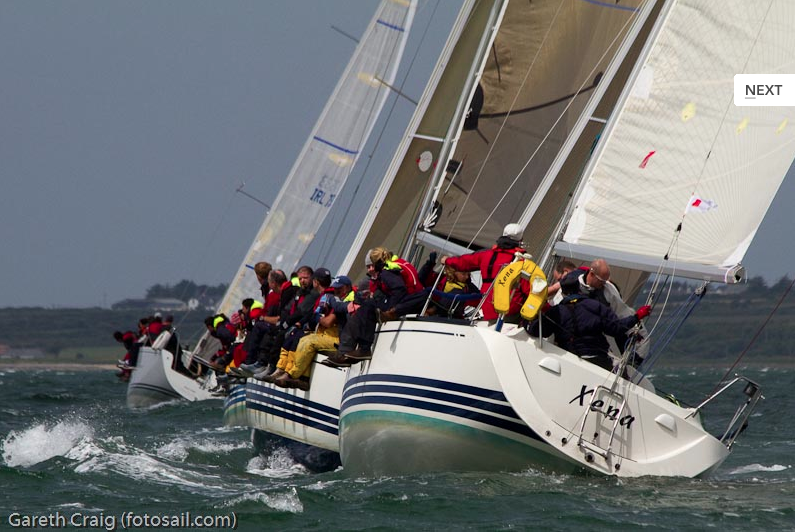
WIORA 2010 Regatta Photos from Kilrush here!
On the gallery are the latest images from Gareth Craig of Fotosail from the West of Ireland Offshore Racing Association (WIORA) Championships being sailed on the Shannon Estuary. Click HERE to go the gallery.
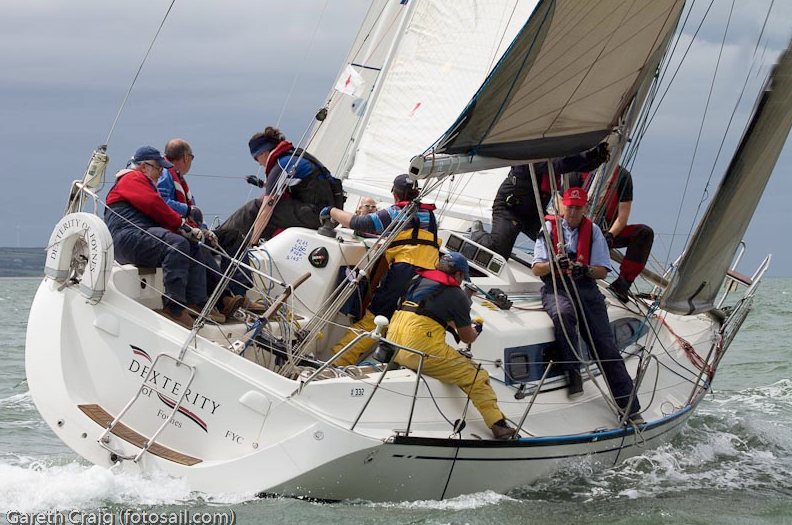
Where to Sail in the West of Ireland
Where to Sail in the West of Ireland
Shannon Estuary – and from Dingle to Slyne Head
At over 100 kilometres long, the Shannon estuary stretches from the western edge of Ireland at Loop Head to east of Limerick city and beyond.
No other waterway brings so much to Irish lives: up to 40% of our energy supplies; Ireland’s second-largest airport; it’s second-largest cargo port; a 10,000 student university – all on the banks of the estuary.
The Shannon Scheme has been bringing electricity to tens of thousands of homes for over 75 years; long before ‘Green Energy’ was heard of in Ireland. This massive award-winning hydroelectric project, producing 85 megawatts of power, was one of the most important building projects ever undertaken in Ireland.
However, it’s not only the ferries and hydroelectric power that are benefiting from the estuary – it seems that all around its banks, people are turning back to face its waters. Limerick’s Riverside City project, initiated during the Celtic Tiger, has helped bring Limerick back to the water.
Four rowing clubs from the city have made this area a main centre for their sport in the country; Kilrush’s development is also encouraging to those who wish to spend time on the water; and Shannon Airport sees approximately three million people pass through its gates on up to 26,000 flights – a forcus for tourism, business and employment since 1946.
The estuary itself, the only one big enough to accommodate Capesize ships (too large for the Suez or Panama Canals), is not only a driving force behind Ireland’s economy but home to the Shannon Dolphin Foundation which allows tourists and locals to dip into that environment from Carraigahold pier. On the Kerry side, Ballybunion’s lush golf links (established in 1893) have entertained up to 100,000 golfing tourists each year.
Limerick city, because of it’s strategic placing, owes it’s origins to the Shannon waters, as from there, smaller boats could access the heart of Ireland while the estuary opened up trade foutes into Europe and beyond. The history of what became known as King John’s Castle is long and fascinating, and Bunratty Castle, built around 1425 a few miles downriver, can attract up to 350,000 visitors each year.
The clutch of islands in the middle of the Fergus estuary – Canon Island, Coney Island, Horse Island and Scattery – were once home to a vibrant, bilingual community fishing and farming around the estuary. Scattery was first used as a monastery site in the sixth century, though the monastery didn’t survive Elizabethan times and it’s population declined steadily after 1881. Because of it’s isolation, the monastery founder St. Senan thought it ideal for his needs – legend has it it forbade any woman to live or land on the island.
Kilrush in Co. Clare is where island residents moved to – making the short journey across the estuary to what once was a small market town but is now the estuary’s marine leisure centre. It’s here that most people learn how to sail on the waterway, as the marina is home to an adventure centre and the area’s largest fleet of racing yachts. So popular is this marina that plans have had to be drawn up to double it’s capacity.
Sailing has a long and proud tradition in these parts: Ger O’Rourke and his yacht Chieftain emerged from these shores, as has Conor O’Brien (left from Foynes in 1923, the first amateur skipper to sail a yacht around the world); and the Knight of Glin who starts the September race.
Brandon Bay, on the north side of the Dingle peninsula, is completely open to the north but reasonably sheltered from the south-east through south-west to north-west. A decent pub with a good bar overlooking the bay provides victuals and refreshment when needed. Mutton Island has sheltered anchorage though no facilities. Kinvarra, small and sheltered, requires some careful pilotage but is good for provisioning. If you make your way to Galway you can enjoy the beautiful city – recent stopover point for the Volvo Ocean Race – with it’s pedestrianised centre. Galway’s sailing club is at Rinville – they may have moorings available though you’d be three miles from any facilities.
Aran Islands – the three: Inishsheer, Inishmaan and Inishmore – are made of limestone and of varied geology. Inishmore is the largest with a secure and sheltered harbour at Kilronan, ferries from the mainland, a supermarket, some restaurants and bars and bicycle hire at the quay. The ancient ford of Dun Aengus is worth a visit: dating from approx. 800BC, it was built as a deterrant to invaders and it’s vast semi-circular structure is quite impressive. The two smaller islands – Inisheer and Inishmaan – do not have safe anchorages.
Continuing up the coast there’s the Greatman and Kiggaul bays – small and requiring a delicate touch if mooring; and St Macdara’s Island at the entrance to Roundstone. Less than half a mile across, it boasts one of the earliest of European churches – a tiny monastery dating from the 6th century. Roundstone itself is a pretty village with shops and restaurants – worth a visit.
From Kinsale to Dingle
It’s generally accepted that the scenery is stunning: rolling hills, coastal cliffs, and substantial mountains. There’s three large inlets which provide havens no matter the wind direction: Dunmanus Bay, Bantry Bay and the Kenmare River. There’s also a mass of islands, lyrically named Roaring Water Bay, which would provide days of sailing experience. With prevailing south-westerly winds, the weather can change rapidly but is normally warm because of the Gulf Stream. Of course, this being Ireland, you could leave port early in the rain but by lunchtime be basking in the sunshine. Excellent Coast Guard radio stations will keep you appraised of changes in weather patterns.


























